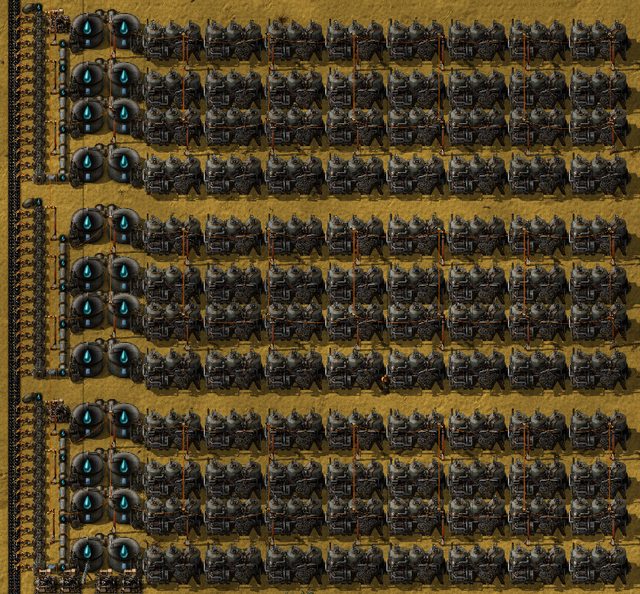Compared with Solar/Accu it is about half as expensive and requires no oil whatsoever and is immune to blackouts (instead at worst you get a brownout)
Compared with pure steam fuel requirements are slashed by 70% and it is immune to low electricity death spiral (where there is no electricity to power the mines and no coal being mined to fuel the boilers).
Compared to Backup Steam it is logic-free and simpler.
Due to pressure dynamics of storage tanks designs closely following the above ratios may require small pumps to work, designs without small pumps can only be discovered by experimentation. Here are two designs which operate optimally under 70/30 conditions and require no small pumps.
My favorite design is a 1/14/32 which produces 16MW and complements 270 Solar Panels (3x shown here):

(Blueprint).
It is space-efficient, reasonably tileable and comes close to optimal ratios
This longer design is a 2/28/66 which produces 33MW and complements 560 Solar Panels:

(Blueprint)
It uses two separate strings of 14 Boilers, each with it's own offshore pump (each offshore pump requires it's own pipe - it wont work if the offshore pumps share a pipe), in practice I find strings of 28 Boilers don't work at 100% when filling tanks unless you use small pump assist, also 3 tanks in series are unable to provide enough water to 11 engines in series, hence the "short circuit" pipes which connect the boiler output to the final tank and allow all the tanks to be filled in parallel, this allows this setup to run at 100% all night, and charge at 100% all day.
It is not as neatly tileable as the 1/14/32 but being longer it makes better use of coastlines, it also has slightly closer to ideal ratios.
I started working with Solar/Steam and hot water storage for ideological reasons, however I have found it to have some serious merits. The usual challenges of larger scale steam power is that it is not easy to blueprint, the water supply and fuel supply it not blueprintable (at least not fully). The advantage of solar/steam following optimal ratios is that the non-blueprintable parts are cut by 70%, making it more than 3x easier to deploy on a large scale.
Compared with Solar/Accu the main advantage is it is seriously cheaper (and steam can even be hand-crafted from common parts with ease). Taking a factory which consumes 30MW, the minimum number of solar panels to provide day time needs is 500, to provide the night time needs with steam requires a 2/28/66 setup. In contrast, to provide the night time needs with Solar/Accu requires adding an additional 215 Solar Panels and 600 Accumulators, not only is the steam setup much cheaper in terms of iron and copper, the accumulators would cost 3000 batteries and we need to consider the comparative advantage of investing that petroleum into other things, such as laser turrets, efficiency models, blue research packs, processing units for armor modules and more, in fact there are a lot of things better than accumulators you can invest petroleum into, in the end game the cheapness argument no longer holds any weight since you've already researched and crafted everything you need and a megabase can churn out accumulators by the thousands.
Solar/Steam has some other fringe benefits. One I like is that it is immune to both blackouts and death spirals. A blackout is when your accumulators go flat leaving you with no electricity whatsoever, but with Daystore Steam the boilers always run, giving you at worst 30% of your power generation as baseline (also designs without small pumps tend to degrade from 100% to 30% gracefully). Also during the daytime you are guaranteed 100% power, if your fuel supply is completely cut off your factory will still run on average at 70% of peak performance.
Solar/Steam does not play well with accumulators because priority will always be charging the accumulators, if you want to use large numbers of accumulators in conjunction with steam, better to use backup steam with a low power condition. Fortunately it's not hard to convert Solar/Steam to Solar/Accu w/ Backup Steam - just replace the first steam engine after the storage tanks with small pumps linked to a circuit network and activated by a low-power condition. You can also just accept that accumulators wont be charged intelligently and just have some for emergencies or as visual low-power detectors (if your accumulators are zapping, you need more electricity generation).






